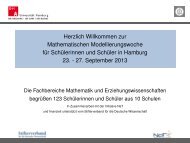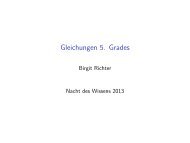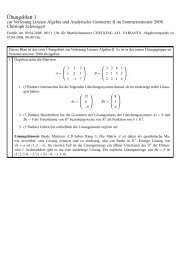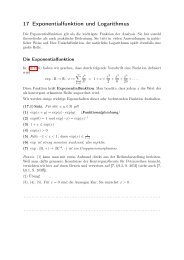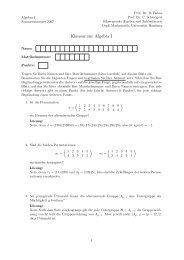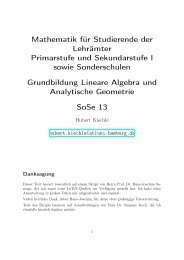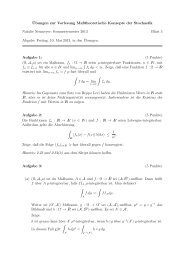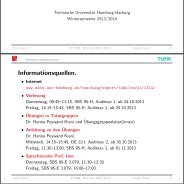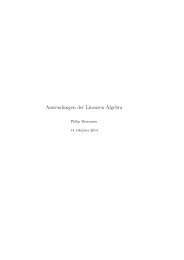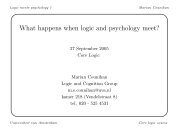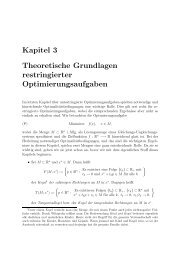pdf file
pdf file
pdf file
Create successful ePaper yourself
Turn your PDF publications into a flip-book with our unique Google optimized e-Paper software.
Examples 2.1.9.<br />
1. It is possible to give a category whose objects are finitely many points and whose morphisms<br />
are arrows.<br />
2. The left modules over any algebra A form a category which we denote by A-mod. The<br />
right A-modules form a category as well which we denote by mod-A. In general, these<br />
categories are not related.<br />
3. If A is a K-algebra, the morphisms Hom(V, W ) have more structure than the one of a<br />
set: they are K-vector spaces, and the composition is K-bilinear. One says that such a<br />
category is enriched over the category of K-vector spaces.<br />
4. Consider a category with a single object • that is enriched over the category of K-vector<br />
spaces. Then End(•) is a K-algebra.<br />
5. A category in which all morphisms are isomorphisms is a called a groupoid. A groupoid<br />
with single object • has a single Hom-space Hom(•, •) that is is a group.<br />
An important example of a groupoid is the fundamental groupoid of a topological space<br />
M: its objects are the points of the space M, a morphism from p ∈ M to q ∈ M is a<br />
homotopy class of paths from p to q.<br />
For the next observation, we need the following notion:<br />
Proposition 2.1.10.<br />
Let (A, μ A , η A ) and (B, μ B , η B ) be unital associative K-algebras. Then the tensor product A⊗B<br />
has a natural structure of an associative unital algebra determined by<br />
and η A⊗B := η A ⊗ η B .<br />
(a ⊗ b) ∙ (a ′ ⊗ b ′ ) := aa ′ ⊗ b ∙ b ′ for all a, a ′ ∈ A, b, b ′ ∈ B<br />
Put differently, the multiplication μ A⊗B is the map<br />
A ⊗ B ⊗ A ⊗ B id A⊗τ⊗id<br />
−→<br />
B<br />
μ<br />
A ⊗ A ⊗ B ⊗ B<br />
A ⊗μ<br />
−→<br />
B<br />
A ⊗ B ,<br />
with τ the twist map τ : a ⊗ b ↦→ b ⊗ a.<br />
Observation 2.1.11.<br />
Modules over a group algebra have more structure.<br />
• Let V, W be K[G]-modules. Then the ground field K, the tensor product V ⊗ K W and the<br />
dual vector space V ∗ := Hom K (V, K) can be turned into K[G]-modules as well by<br />
g.1 := 1 for all g ∈ G<br />
g.(v ⊗ w) := g.v ⊗ g.w for all g ∈ G, v ∈ V and w ∈ W<br />
(g.φ)(v) := φ(g −1 .v) for all g ∈ G, v ∈ V and φ ∈ V ∗ .<br />
(In physics, the representation on K is used to describe invariant states, and the representation<br />
on V ⊗ W corresponds to “coupling systems” for symmetries leading to multiplicative<br />
quantum numbers.)<br />
10




